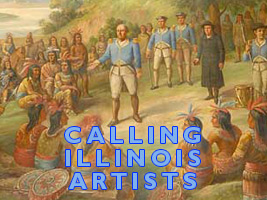- Details
 Did you know? The zipper was invented in Chicago by Talon Zipper, founded in 1893.
Did you know? The zipper was invented in Chicago by Talon Zipper, founded in 1893.
Before creating the zipper, Talon Zipper was best known for producing a hook-less fastener for shoes and boots. They observed a need in the fashion world for an easier method of fastening clothes than the dozens of buttons on fashionable high-button boots, and the zipper was born.
- Details
 Did you know? The first handheld cell phone was developed by Martin Cooper of Schaumburg.
Did you know? The first handheld cell phone was developed by Martin Cooper of Schaumburg.
Martin left his first job at Teletype Corporation in Chicago in 1954 and joined Motorola, Inc. (Schaumburg, Illinois) as a senior development engineer in the mobile equipment group. He developed products including the first cellular-like portable handheld police radio system, produced for the Chicago police department in 1967. His inspiration for a cordless phone came from an episode of Star Trek when Captain James T. Kirk opened his communicator.
- Details
 John G. Shedd Aquarium, currently Shedd Aquarium, is an indoor public aquarium that opened in Chicago Illinois in 1930. The aquarium has up to 1,500 different species of not only aquatic animals but other species such as birds, snakes, amphibians and insects. It had the first inland aquarium with a saltwater fish collection.
John G. Shedd Aquarium, currently Shedd Aquarium, is an indoor public aquarium that opened in Chicago Illinois in 1930. The aquarium has up to 1,500 different species of not only aquatic animals but other species such as birds, snakes, amphibians and insects. It had the first inland aquarium with a saltwater fish collection.
Shedd Aquarium was designed by one of Chicago’s most prestigious architectural firms, Graham Anderson, Probst & White. The firm has created buildings such as the iconic Terminal Tower in Cleveland and Federal Reserve Bank in Kansas City. The design of the aquarium was in the Beaux-Arts style, with elements of classical Greek architecture to make it a better structural match with the neighboring Field Museum.
It was the most visited aquarium in the U.S in 2005 and in 2007. It is now a National Historic Landmark because of its expansions and additions. These expansions included exhibits such as vast habitats for marine animals and large sharks and rays.
For More information on this amazing aquarium and its legacy Click Here
- Details
 Did You Know? Chicago native Lorraine Hansberry won the New York Drama Critics Circle Award for “A Raisin in the Sun,” the first play by an African-American woman to be presented on Broadway.
Did You Know? Chicago native Lorraine Hansberry won the New York Drama Critics Circle Award for “A Raisin in the Sun,” the first play by an African-American woman to be presented on Broadway.
“A Raisin in the Sun” was originally a book that highlights the life of black Americans living through the years of racial segregation in Chicago. Hansberry won the coveted New York Drama Critic's Circle Award for the novel at only 29 years old. The play opened March 11, 1959 at the Ethel Barrymore Theatre, running 530 performances.
In 1961, “A Raisin in the Sun” debuted as a dramatic film, directed by Daniel Petrie. In 2005, the film was selected for preservation in the United States of America National Film Registry by the Library of Congress as being "culturally, historically, or aesthetically significant." The film was later revived for television in 2008, directed by Kenny Leon and starring well-known actors and actresses such Sean Combs (P. Diddy), Phylicia Rashad and Sanaa Lathan.
“A Raisin in the Sun” won three Emmy nominations for its television production, while the play won Tony Awards in 2004 and 2014, including Best Revival of a Play. It is considered one of the hallmarks of American stage and remains a classic, with its themes of dreams and struggle, family and the home, still resonating today.
- Details
 Did you know? The world’s first skyscraper was built in Chicago Illinois.
Did you know? The world’s first skyscraper was built in Chicago Illinois.
The Home Insurance Building was a skyscraper in Chicago. Built in 1885, it had 10 stories and rose to a height of 138 feet. It was the first tall building to be supported by a steel frame. With the ability to use a material lighter than brick, the building could carry more weight, allowing for the structure to rise much higher and carry its own weight more safely. The majority of the structure used cast and wrought iron.
The designer, architect William Le Baron Jenney, also designed the Horticultural Building for the 1983 World's Columbian Exposition held in Chicago. His designs earned him the nickname “The Father of the American Skyscraper.”
Scholars regard the Home Insurance Building as a key example of the Chicago School of Architecture, serving as an early template for skyscraper architecture. The building was demolished in 1931 to make way for the Field Building (now known as the LaSalle Bank Building). It stood for 46 years. If you would like more information on this building or its architect click here.
More Articles …
- Did you know? Chicago’s Lincoln Park Zoo is the oldest public zoo in nation.
- Did you know? May 18th is National Museum Day.
- Did you know? Frederic W. Goudy was an American printer and typographer from Bloomington who designed more than 100 typefaces.
- Did you know? The horseshoe sandwich was invented in Springfield Illinois by Joe Schweska in the 1920’s.
- Did You Know? Julia Clifford Lathrop, an American social welfare worker, was the first woman to ever head a United States federal bureau.





